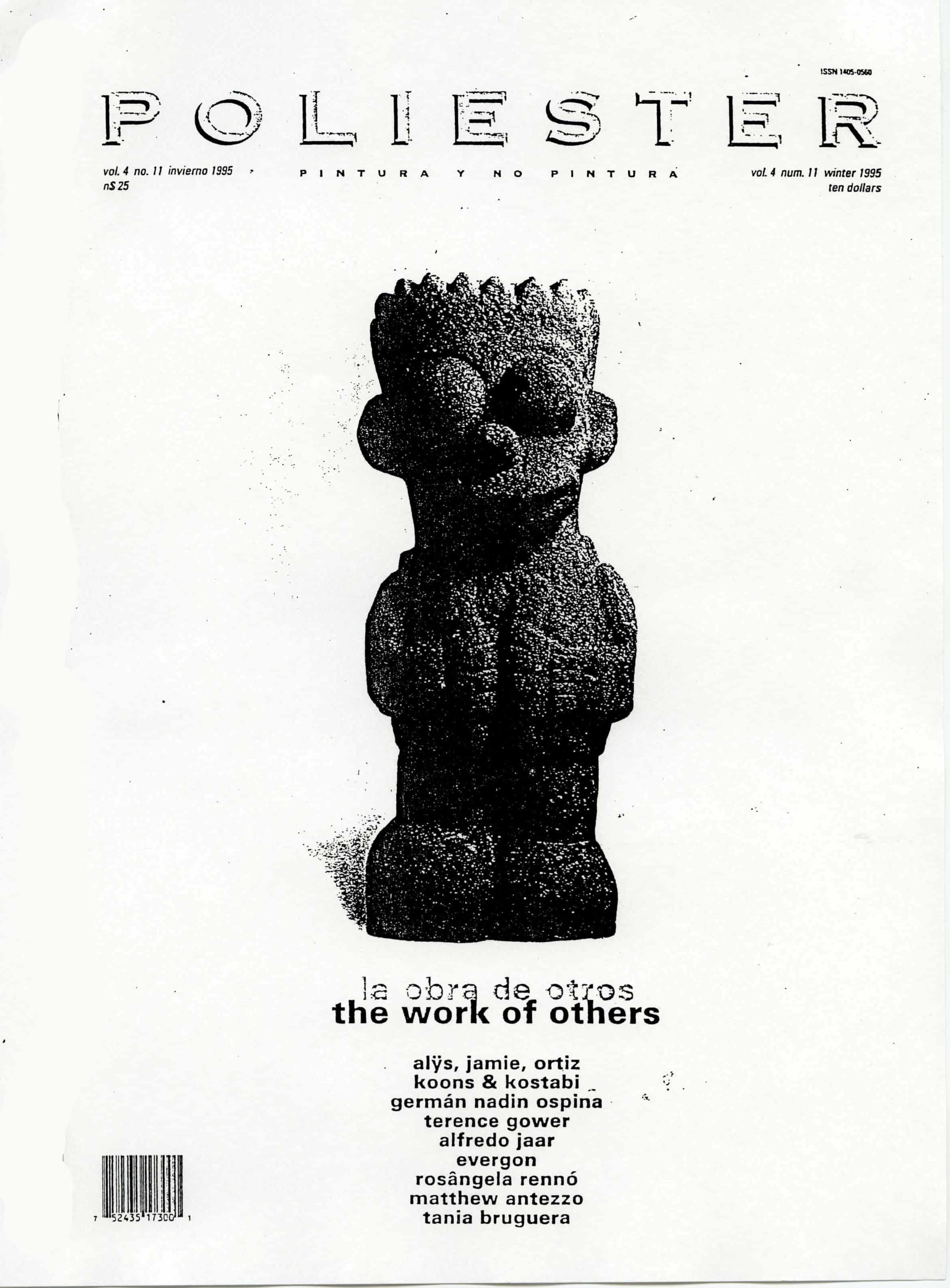Gerardo Mosquera
Winter 1995
From: Mosquera, Gerardo. “Resucitando a Ana Mendieta,” Poliéster, vol.4, no.11, Invierno, Ed. Kurt Hollander. México D.F., México, 1995 (illust.) pp. 52 – 55.
ISSN 1405-0560
Reanimating Ana Mendieta
by Gerardo Mosquera
Tania Bruguera, together with Carlos Estévez, Luis Gómez, Ricardo Brey and Rubén Torres Llorca, represents an area of new Cuban art derived from the possibilities opened up by the already mythical Juan Francisco Elso (1958-88). These artists were his friends and the younger ones were disciples of the extraordinary teachings of Elso, an integral part of the general process of his work as a mystical-pedagogical experience of art. These artists, each in his or her own way, make sculptural installations that are usually instruments of an existential experience, using methodologies that are closely allied to religion and which stimulate the symbolic dimensions of the materials. These methodologies help codify artistic-philosophical discourses of a transcendental nature, whose reflections range from cosmology to contemporary problems, always using a carefully structured symbolism.
Among them, the work of Tania is most grounded in process and at times performance, as can be seen in the importance of certain acts and developments during the elaboration of her works, in addition to her actual performances, which constitute an important sector of her work, and which sometimes interact with her installations. The process of her work is often linked to personal experience, in a kind of symbolic ritualization of her own acts and selfwareness. Bruguera is always striving to unite artistic practice with life.
Sometimes the works make social commentaries, but they are always derived from a personal perspective, an intimate feeling. Such is the case with the performance and installations she made of black marble, a kind of monument to those who had disappeared.
The concern for others, the opening up of herself to them, is evident in a work such as Memories of the Postwar Era, and underground cultural publication, the first one to be made in Cuba, that published articles on the visual arts, culture and society, as well as literature, photography, drawings, news, etc.
The social dimension of her work is not only the subject, it is also in Cuba, defying the tensions on both sides that hinder Cuban unity inside and outside the island, dividing us according to a bipolar scheme that only serves to perpetuate the status quo.
Despite the mythical aura that surrounds her, Mendieta is not well know among younger Cubans. This is due to the silence of the media and the official culture, a disinterest that has allowed the destruction of part of her Cave Sculptures in Las Escaleras at Jaruco and the abandonment of the other works. Today it is difficult to locate this site, when in fact it should be declared a national monument because of its historical, artistic and cultural importance.
But Bruguera has created a more fitting homage. She has managed to publicize her work, her life and the metaphor of union among Cubans that Mendieta represents. Her procedure was to duplicate this metaphor: Bruguera, just like Pierre Menard, has repeated some of Mendieta’s works and has carried out others that Mendieta only sketched. As if taking possession of Mendieta, she reenacted her performances, the same thing that, coincidentally, Nancy Spero did.
Bruguera “appropriated” Mendieta not just by remaking or reinventing her works but also in the very approach to art as something ritualistic and personal. Elso’s practice, which was influenced by Mendieta in the beginning, reencountered her again through Bruguera.
These works are a surprising example of the capacity of contemporary art to pay homage through its own resources. Appropriation, conceptual art and process were used to achieve this homage through an artistic consubstantiation open to multiple meanings. Bruguera indentified with Mendieta in order to bring her back to the island and to the present day, to rework her in order to show her art to the new generations and to recover her presence in the collective imagination. In this way, Mendieta’s myth is promoted through a quasi-religious artistic ritual, which is itself based on Mendieta’s multicultural myth.
It could be said that Bruguera’s work closes the circle of Mendieta’s work by solving the obsession that fueled it. P to her death Mendieta expressed tragically her inability to solve her desire to return in both a symbolic and physical way. Her death was her last work, as it left the silhouette of her body on a New York City sidewalk. Tragic heroes become gods and the return to Earth to take possession of their followers, as in the Afrocuban religions that were a main inspiration for Mendieta’s work. Her conflict was solved through a vicarious return that manifests a presence on this side, both imaginary and living: Tania Bruguera displaced the silhouette of death and became her final silhouette, walking the streets of Old Havana. This transubstantiation is also a utopic image of the possible union of all Cubans on the island and beyond.
